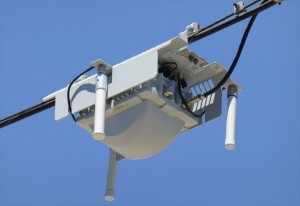
In the midst of its deployment of WiFi (and likely more) in Southern California, Time Warner has started to install WiFi nodes manufactured by Ruckus Wireless, specifically the Ruckus ZoneFlex 7761-CM.
Previously, Time Warner has been widely deploying Belair Networks gear.
The Ruckus 7761-CM is an intriguing node, supporting “8 downstream and 4 upstream bonded channels with theoretical data rates of up to 340 Mbps (downstream) and 130 Mbps (upstream).” Okay, those are theoretical data rates, but even if they can only achieve half that, this is still a box to be contended with by competitors, and enjoyed by users.
The Ruckus gear, like Belair’s equipment, is plant-powered and strand mounted. This means that TW (or any cable operator using this configuration of equipment) can often deploy WiFi without going through the joint pole committee for permission, and likely permissibly…or not..bypassing the local cable franchising authority.
An interesting use for the 7761-CM is delivering broadband services from outdoors to extend managed wireless LANs (WLANs) locations and where Ethernet cabling is not feasible. In English, this means that these boxes can be used to provide point-to-point Ethernet (10, 20, 100 Mbs etc) which would have typically required fiber extension.
In states like California, which restrict how non-cable services are provided via cable plant, this box continues TWs apparent encroachment outside the bounds of its state-issued cable TV franchise and its CPCN restricting deployment of business services to cable users.
For an interesting map of TW’s current deployment, check out Time Warner’s WiFi/3G/4G map here.
WiFi (and 3G/4G) node deployment is something that should be carefully evaluated by governments, and by the DAS industry.
For governments, the questions center around about who regulates what services, permitting, and proper compensation for the use of the public rights-of-way from local users, hourly users, and users from other cable systems and operators granting access on a reciprocal basis. I’m working with several of my government clients crafting language in their new wireless ordinances to address these issues.
For the DAS industry, its single greatest threat is cable TV’s deployment of wireless nodes using the existing CATV plant for backhaul, and the overhead strand and pedestals for radio mounts. The cable TV industry beats DAS hands down every time for deployment economics and time-to-market. For more on this, see my article in the April 2102 edition of AGL Magazine.
Jonathan
PS: I snapped the photo for this article just 1/2 block south of my office here in Los Angeles. -jlk